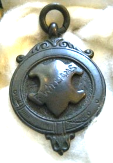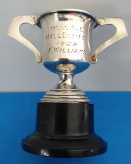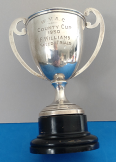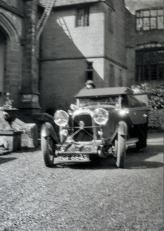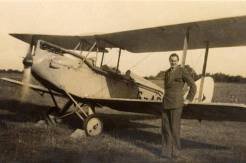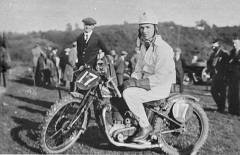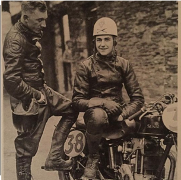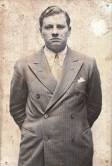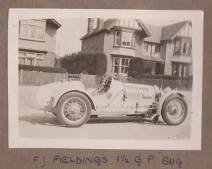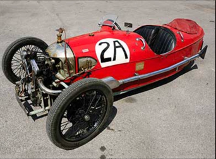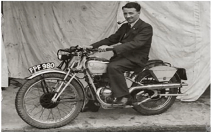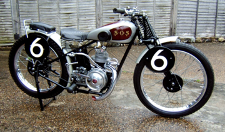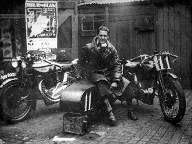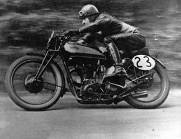Title: | Wye Valley Auto Club Speed Trials At Michaelchurch Court, 1931-34 |
Date: | 1931 - 1934 |
Guest Contribution Introductory Note:
Randolph Trafford was Lord of the Manor of a part of Ewyas Lacy by virtue of his ownership of the Michaelchurch Court Estate. His home in Herefordshire was at Michaelchurch Court in the parish of Michaelchurch Escley, more details of which [and of the Trafford family history] are given elsewhere on the website. Randolph Trafford’s descendant, James Baxendale, has written an account of his involvement with the Wye Valley Auto Club and speed trials at Michaelchurch which is reproduced in full below with the author’s kind permission.
Ewyas Lacy Study Group
WYE VALLEY AUTO CLUB SPEED TRIALS AT MICHAELCHURCH COURT, 1931-34
Course record set by Eric Fernihough, motorcycle world land speed record holder
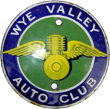
Wye Valley Auto Club
The Wye Valley Auto Club (‘WVAC’) was founded in around 1923, when a number of enthusiasts from Hereford and Ross got together to form a motorcycle and light car club.[1] The Club held annual speed trials in Hereford (the ‘Hereford Speed Trials’) between 1923 and 1925, before speed trials were banned on public roads in 1925.[2]
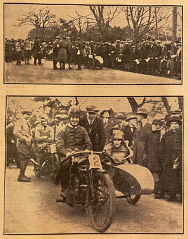
1925 Hereford Speed Trial
Top picture: the start
Bottom picture: Mr L. W. Hall
and Miss Lewis (his passenger)
The WVAC affiliated itself to the Auto Cycle Union (‘ACU’) Western Centre in 1927[3] and at some stage merged with the Hereford Motor Cycle Sports Club (‘HMCSC’).[4]

WVAC car grill badge,
including HMCSC below[5]
The WVAC held a motorcycle trial on 29 July 1929, known as the ‘Meredith Cup’,[6] over 76 miles around south Herefordshire and a hill climb for solo motorcycles at Dinmore on 5 September 1929, the latter being won by Frank Williams, a well-known local rider, whose cups survive to this day. The hill climb was reported as only the second event of its kind promoted by the Club since the speed trials of 1924, the other having been held a few months ago , with nearly a thousand spectators attending.[7] In 1930, there was a treasure hunt on 28 August,[8] and on 4 September a ‘Safety First’ run.[9] Frank Williams again won the County Cup at the speed trials of that year, for the fastest novice rider resident in Herefordshire.
|
|
|
|
| Third class medal 1929 WVAC Meredith Cup[10] | 1929 Hill Climb Cup | County Cup 1930 Speed Trials |
| Frank Williams’ cups and medals[11] | ||
The Michaelchurch Court Speed Trials
The WVAC annual speed trials at Michaelchurch Court lasted from 1931 to 1934. Albeit largely for motorcycles – cars participated in 1931 and 1932 – the speed trials appear to have been a continuation of the Hereford Speed Trials (albeit over a far shorter distance) and attracted a number of well-known names. Percy Chadney was the secretary of the club for all four speed trials.[12]
Course
The course was a quarter mile in length up the Michaelchurch Court Drive (on a couple of occasions it is recorded as 400 yards[13] ). It is variously described:
A better course could not have been selected from the point of view of surface and natural beauty. The observed section, which covered a stiff hill climb for a distance of 400 yards, ran through an avenue of beautiful trees.[14]
A quarter-mile course had been measured on the drive. For some distance from the starting point the course was straight, but a considerable turn yards before the finish made the trial a little less easy for the competitors, and more interesting for the spectators.[15]
The course is a private drive with a good surface and is about a quarter of a mile in length, the average gradient being one in 12.[16]
Hedley Wilding was a teenager when the speed trials were being run. His father ran the well-known local petrol station at Turnastone.[17] He attended the events. He recalled that the speed trials used to be held down the front and back drives of the Court. According to him, somebody was directed to stand at the entrance to the Court to ensure that no cars were coming in the opposite direction when the cars sped out of the drive onto the road.[18]
Prizes
There were four prizes:
- John Bull Cup: fastest time
- County Cup : fastest novice rider resident in Herefordshire
- Naylor Trophy: fastest three-wheeled vehicle
- Stewart Challenge Shield: fastest car
Randolph Trafford, the owner of Michaelchurch Court, was an enthusiastic aviator and owned a number of sports cars. By the time of the first speed trial, aged just 24, he was already on his second plane and his third car, a Lagonda 2 Litre Speed Model,[19] which he had bought the year before, taking it to Brooklands for the Lagonda Fête in July 1930 (his previous cars were a 1922 Rolls Royce Silver Ghost and an Amilcar, likely a 1926 Amilcar CGS).
|
|
|
| Lagonda (GF 8843) in front of Michaelchurch Court, 12 August 1931 | Randolph next to his Gypsy Moth (G-ABAM) |
Randolph never owned motorcycles, and although he subsequently became president of the WVAC, there is no evidence that he participated in the speed trials – although Harold Butcher recalled that he used to turn his Rolls Royce into the Michaelchurch Court drive using full-lock and full-throttle.[20] In Randolph’s diary entry for 20 August 1931, he wrote, “I came back [from Tenby, a distance of 100 miles] in 2 hrs 22 minutes home, & found Motor Bike trials in full swing on the drive ”.[21]
First Michaelchurch Court Speed Trials: 20 August 1931
The motor-cycle speed trial organised by the Wye Valley Auto Club at Michaelchurch Court, Michaelchurch Escley (by permission of Mr. R. R. W. R. Trafford), on Thursday, provided a pleasant and, at times, thrilling afternoon’s sport for a large crowd of interested spectators. The variety of classes, and the magnificent trophies offered for competition, attracted a large list of entrants, including well-known figures in the motoring world. [22]
The prizes were awarded as follows:
- John Bull Cup: Frank Williams (4.93 Sunbeam): 16 4/5 secs.
- County Cup : W. H. Franzen (4.90 Norton): no time given.
- Naylor Trophy: T. G. Eldridge (3.46 Montgomery): no time given.
- Steward Challenge Shield: Jim Sugg (Wolseley Hornet): 27 2/5 secs.

1931 WVAC ‘John Bull’ cup
Awarded to Frank Williams[23]
Frank Williams, the winner of the John Bull Cup both in 1931 and 1933, owned a bicycle and motor shop in Bromyard, founded by his father, Edmund.[24] He was one of four members of the Sunbeam Works Trials Team. He competed in the Isle of Man TT, coming eight in the 1932 Senior Manx Grand Prix,[25] but was forced to retire in the 1933 race. He later transferred to karting.
Frank William’s 493 c.c. Model 9 Sunbeam, which he used in the Speed Trial, may be a 1929 model, registration number DV 374 (frame no D5976, engine no LL3353).[26]
|
|
|
| Frank Williams at Whitley Hill, near Warwick, June 1931[27] | Frank Williams astride a works hybrid Sunbeam 90 at the 1932 Manx GP. Journalist, and proto-hipster, J.S. Ward, to his left.[28] |
The winner of the Steward Challenge Shield for the fastest car was Jim Sugg in a Wolseley Hornet. He appears to have used the same car (registration number CH 9869)[29] in the Inter-Varsity Trials a few months later on 14 November 1931. Sugg was principally a motorcyclist for Norton,[30] participating in the Isle of Man TT races from 1928 to 1935, coming third in the 1929 Senior MGP.[31] At the Michaelchurch Court Speed Trial, he came second on his Norton in the 490cc class, likely on registration number OF 9502, which had been delivered to him in Derby just three days earlier. Sugg rode OF 9502 three weeks later in the Senior Manx Grand Prix on 10 September, when he came eighth.[32]
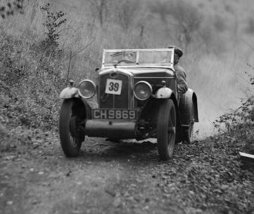
Jim Sugg competing in his Wolseley Hornet (CH 9869)
in the Inter-Varsity Trial, 14 November 1931[33]
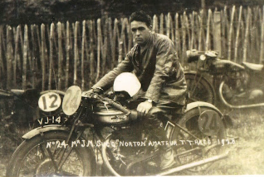
Jim Sugg, 1928 Senior Manx Grand Prix

Publicity photo of Reg OF 9502
Norton delivered to J M Sugg, Derby on 17 August 1931[34]
Second Michaelchurch Court Speed Trials: 13 August 1932
Randolph may have been made president of the WVAC in 1932[35] . He was certainly more involved in the Club’s activities that year. On 23 June, the WVAC held a 31 mile paper chase over very rough country. The ‘hare’ was Randolph, who was caught just before he reached Madley.[36] In July the Hereford Times reported on a social meeting of the Western Centre of the ACU:
On Sunday, at the Weir End, Ross-on-Wye, a motor rally was held under the auspices of the Western Centre of the Auto-Cycle Union. Over 100 motor-cycles and cars were present, whose drivers took part in the various sports and competitions such as chasing an aeroplane piloted by Mr RRWR Trafford, egg and spoon motor-cycle race, three-legged football match, and guessing competitions.
Mr Trafford also gave a demonstration to the gathering of how not to fly, an exhibition which provided plenty of thrills and excitement for the onlookers. …
Motor clubs from Cheltenham, Gloucester, Tewkesbury, and Worcester were there in force, but the Wye Valley Auto Club had, as might be expected, the greatest number of representatives. [37]
As, for the speed trial itself, the Hereford Times , noted:
The annual speed trials are to be held at Michaelchurch Court on Saturday, August 13th , and as it is understood that the Madresfield trials will not be held this year it is probable that there will be good entries.[38]
On the day itself:
[A]bsence of accidents and good organisation made the trial a great success, and the weather was favourable except for a short shower. There was only one spill. A. F. Durdle, on his Excelsior, once made a bad start, and could not control his skidding machine, but he was not hurt.[39]
The prizes were awarded as follows:
- John Bull Cup: C. A. Allan (348 Rex Acme): 13 secs.[40]
- County Cup: I. W. Williams (496 Scott): 19 2/5 secs.
- Naylor Trophy: Clive Lones (1098 Morgan): 17 1/2 secs.
- Stewart Challenge Shield: Jim Fielding (1500 Bugatti): 18 4/5 secs.
Jim Fielding[41] won the Stewart Challenge Shield in his 1926 1½ litre Type 37 Grand Prix Bugatti (chassis no 37225, registration no YF 4747).[42] The car is still in existence. Fielding, who was mad on sports cars,[43] was later Managing Director of their family engineering firm, Fielding & Platt Ltd, Atlas Works in Gloucester. He regularly participated in races and hill climbs in the 1930s,[44] including the Amateur Hill Climb at Shelsley Walsh on 5 September 1931 as a member of the Bugatti Owners; Club team (the team, which consisted of Fielding, Noel Carr[45] and Alexander Spottiswoode,[46] came first – F. J. Fielding’s Bugatti was very fast though rather wild , noted Motor Sport[47] ) and at Brooklands in May 1934, Motor Sport remarking that Fielding’s car attracted a good deal of attention in the Paddock on account of its beautiful finish, but it was not in its Shelsley-form during this race .[48]
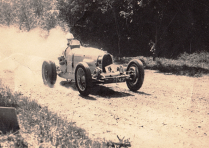
Jim Fielding in his Bugatti[49]
Clive Lones[53] was one of the best Morgan three wheeled racers before the Second World War. He set 37 world and national records at Brooklands, including winning the Cyclecar Grand Prix in a Morgan JAP with his wife, Nel, at the Brookland’s New Cyclecar Club Meeting on 25 August 1928. After the Second World War, Lones became a pioneer of 500cc car racing[54] Lones’ Morgan, which he used from 1929 to 1935, is now in the Brookland’s museum.[55]
Third in the three wheeled race was Tom Rhodes, also in a Morgan. Rhodes was a garage owner in Liverpool and part of the Morgan works team with Lones, participating with him in the three car Morgan team in the Light Car Relay Grand Prix at Brooklands from 1931 to 1934. He achieved the fastest time of the day in both the 1933 and 1934 races.[56] In 1934 Rhodes achieved a gold star at the British Motorcycle Racing Club (‘BMCRC’) meeting for a lap speed of 103.76mph.[57] The car, registration number YY49, was owned for 60 years by Bill Wallbank, and still exists.
|
|
|
| Clive Lones with his wife, Nel Morgan JAP, 1928 New Cyclecar Club Meeting, Brooklands[58] | Clive Lones in his Morgan JAP, Brooklands 1932[59] |
|
|
|
| Clive Lones’ Morgan JAP, Brooklands Museum [60] | Tom Rhodes’ Morgan (YY49)[61] |
Frank Williams came second in both the 350cc class on his own F.W. Special,[62] with a time of 20 2/5 secs, and the unlimited cc class on a 490 Sunbeam, with a time of 15 1/5 secs. We have his medal from the day.[63]
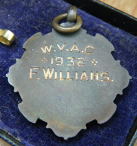
Frank Williams
Second class medal
1932 Speed Trials[64]
Third Michaelchurch Court Speed Trials: 19 August 1933
The Hereford Times reported:[65]
After the event had been cancelled, the Wye Valley Auto Club speed trials at Michaelchurch Court on Saturday were made into a really good show. There was fine weather and good sport, and fewer entries and a small attendance took away little from the customary success of the event.
The prizes were awarded as follows:
- John Bull Cup: Frank Williams (490 Sunbeam): 15 4/5 secs;
- County Cup : J. Duffy (499 Rudge): 16 2/5 secs;
- Naylor Trophy: L Pritchard (490 Rudge with sidecar): 23 1/5 secs.
The Stewart Challenge Shield was not awarded, no cars having participated.
Len Vale-Onslow won the 250cc class in his 250 S.O.S. with a time of 20 2/5 seconds. The S.O.S. (Super Onslow Special) bikes were owned and manufactured by Vale-Onslow in Hallow, Worcestershire, from 1927 to 1939.[66] [67]
|
|
|
| c.1933 S.O.S. 172cc Model AA ‘Brooklands’ Racing Motor Cycle[70] |
Fourth Michaelchurch Court Speed Trial: 18 August 1934
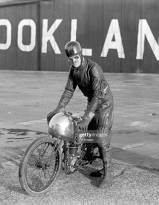
Eric Fernihough.
Brooklands, 31 October 1933[71]
The final speed trial held on the drive was without a doubt the most exciting. Eric Fernihough (known as ‘Ferni’),[72] who was three years later to take the motorcycle world land speed record, set a new course record, the Hereford Times reporting:
This was created by E. Fernihough (Excelsior), who covered the quarter mile, which has an average gradient of 1 in 12, in 14 3-5 seconds – a fifth of a second quicker than the previous best time held by F. Williams (Sunbeam).[73]
By the time that Fernihough took part in the Michaelchurch Speed Trial, he was already a very well-known name, having won many major races at Brooklands on Excelsiors. He had also won numerous Grand Prix: the North West 200 three times between 1930-32; the French UMF Grand Prix five times between 1930-34; the Belgian Grand Prix in both 1931 and 1932; and the Swedish and Dutch Grand Prix in 1932.
The year after the Michaelchurch Speed Trial, Fernihough moved to setting speed records on Excelsiors. In 1936, he set a new motorcycle land-speed record for solo motorcycles over the flying mile with a speed of 163.82 mph and improved the flying kilometre world record in April 1937, using a 1000 cc JAP engine with a speed of 169.79 mph.
Fernihough crashed and was killed on 23 April 1938 at Gyón, Hungary, while attempting to regain the land-speed record on his Brough Superior JAP, which had been taken from him by BMW’s Ernst Jakob Henne in November 1937, with a speed of 173.68 mph.
The speed trial was intensely competitive. Just behind Fernihaugh was Bob Burnie, who recorded 15 seconds in his Norton, followed by A Beart on his Zenith. Burnie, who was an accountant at Fort Dunlop in Birmingham and remained an amateur, won a number of races throughout the 1930s[74] Beart was very likely Francis Beart.[75] By the early 1930s Beart was a Brooklands regular, working with Fernihough. Beart campaigned on a number of machines, including Zenith and Douglas.[76]
|
|
|
| Bob Burnie[77] | |
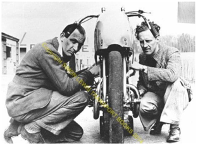
Francis Beart (left) and Noel Pope, Brooklands, 1930s[78]
Randolph was there to witness the new record, acting as one of the two stewards for the meeting.
The prizes were awarded as follows:
- John Bull Cup: Eric Fernihough (496 Excelsior): 14 3/5 secs;
- Country Cup: W. A. Parker (350 A.J.S.): 18 3/5 secs;
- Naylor Trophy: I. J. Webb (976 Enfield side-car): 21 2/5 secs.
No cars appear to have participated.
An end to the Michaelchurch Court Speed Trials
The speed trials came to an end in 1934. A possible reason was Randolph’s lack of interest: he was an aviator, not a motorcyclist. Randolph had held his first air rally at his private airfield at Michaelchurch the previous month,[79] something that he was to repeat on a bigger scale in 1937.[80] The absence of cars participating after 1932 may have dampened his enthusiasm.
The WVAC moved to holding grass trials, which seemed to have been even more popular, attracting crowds of up to 1,400 spectators. Two meetings were held at the King’s Acre Filling Station Ground in August[81] and September[82] in 1935 and again in 1936 (also in August[83] and September[84] ). In 1937, a new course was found at Walnut Tree Lane “The new layout, which includes a “hair-pin” bend, was expected to be conducive to more thrilling racing than the Kings Acre track, and so it proved ”.[85]
James Baxendale
April 2023
ANNEX
CLASS RESULTS
1931[86]
172 c.c.: T. Wall (S.O.S.), time 22 3/5 secs.
249 c.c.: G. Powell (A.J.S.), 22 secs.
350 c.c.: 1. C. A. Allan (Rex-Acme), 17 4/5 secs.; 2. A. T. Howard (Norton), 19 4/5 secs.
490 c.c.: 1. F. Williams (Sunbeam), 16 4-5 secs.; 2. J. M. Sugg (Norton), 18 2/5 secs.
Unlimited: 1. F. Williams (Sunbeam), 16 4/5 secs.
Motor-cars: 1. J. M. Sugg (Wolseley-Hornet), 27 2/5 secs.
1932[87]
350 c.c. Class. – 1. C. A. Allen (348 Rex Acme), 13 seconds; 2 (tied), F. Williams (348 F.W. Special), 20 2/5 seconds and J. Pettigrew (348 Ariel), 20 2/5 seconds.
500 c.c. Class – 1. C. A. Allen (348 Rex Acme), 13 seconds; 2. A. F. Durdle (498 Excelsior), 15 1/5 seconds; 3. M. Saunders (499 Rudge), 15 4/5 seconds.
Unlimited c.c. Class – 1. C. A. Allan (348 Rex Acme), 13 Seconds; 2. F. Williams (490 Sunbeam), 15 1/5 seconds; 3. M. Saunders (499 Rudge), 15 4/5 seconds.
Three-wheel Vehicle Class. – 1. H. C. Lones (1098 Morgan), 17 1/5 seconds; 2. W. E. Hayward (498 Baugham), 19 1/5 seconds; 3. T. A. Rhodes (1098 Morgan), 19 4/5 seconds.
Car Class. – 1. F. J. Fielding (1500 Bugatti), 18 4-5 seconds; 2. H. Brown (3000 Rover), 22 2/5 seconds; 3. H. J. Jeffcoat[88] (2000 Wolseley Hornet), 23 2/5 seconds.
1933[89]
250 c.c. class – 1. L. H. Vale-Onslow (250 S.O.S.), 20 2/5 secs. (expert).
350 c.c. class. – 1. J. McNulty (350 Rudge), 17 secs. (expert barred).
350 c.c. class. – 1. F. Stephens (350 Rudge). 16 4/5 secs. (expert).
500 c.c. class. – 1. J. Duffy (499 Rudge), 16 2/5 secs. (local novice). 1. J. McNulty (350 Rudge), 17 secs. (expert barred). 2. J. H. James (499 Rudge), 17 2/5 secs. (expert barred). 1. F. Williams (490 Sunbeam), 15 4/5 secs. (expert).
Unlimited c.c. class. – 1. F. Williams (490 Sunbeam), 15 4/5 secs. (expert).
Three-wheeler class. – 1. L. Pritchard (490 Rudge with sidecar), 23 1/5 secs. (expert).
1934[90]
175 c.c. (expert): T. Wall (175 S.O.S.), 22 4/5 secs.
350 c.c. (expert): E. Stephens (Stephens Special), 17 2/5 secs.
350 c.c. (expert barred): J. McNulty (Rudge), 18 2/5 secs.
350 c.c. (local novice): W. A. Parker (A.J.S.), 18 3/5 secs,
500 c.c. (expert): E. Fernihough (Excelsior), 14 3/5 secs.
500 c.c. (expert barred): J McNulty (Rudge), 18 2/5 secs.
500 c.c. (local novice): J. Orgee (Rudge), 17 4/5 secs.
Unlimited c.c. (expert): R. J. D. Burnie (Norton), 15 secs; Unlimited c.c. (expert barred): A. Beart (Zenith), 16 secs.
Three wheelers, unlimited c.c. (expert barred): I. J. Webb (976 Enfield sidecar), 21 2/5 secs.
[1] At the time, the WVAC was known as the Wye Valley Motor Cycle and Light Car Club (‘Wye Valley MC and LCC’).
[2] The speed trials were held on 14 July 1923, 31 May 1924 and 4 April 1925 on the road south of Hereford to Holme Lacey. VSCC Bulletin , no 304, Summer 2019, pp 92-93. The 1923 and 1924 speed trials were held over a straight mile course. The course for the 1925 speed trial, on the main Hereford to Hay-on-Wye road, was half a mile in length. The principal participants in the 1925 speed trial were motorcyclists, with the fastest rider, I. P. Riddoch, on a 988 Zenith, achieving an average speed of 94¾ mph. The Hereford Times , 11 April 1925, p12, reported that the trials were conducted under the auspices of the Western Centre ACU.
[3] https://trialsguru.net/east-midland . The ACU, formed in 1903, is the National Governing Body for motorcycle sport in the UK (less Northern Ireland). The Western Centre covers Gloucestershire, Herefordshire and parts of Worcestershire – officially those parts of Hereford and Worcester and Gloucestershire situated south of a line from Brimfield through Worcester, Evesham and Moreton-in-Marsh to the junction of the Oxfordshire and Warwickshire boundaries and north of a line east/west through Dursley. https://www.acu.org.uk/centres-clubs/centres/western/ .
[4] The Hereford Motor Cycle Sports Club was still in existence in 1944, holding a grass track meeting at Hereford Racecourse on 21 October 1944. Western Daily Press , 11 October 1944.
[5] Badge in the possession of the author.
[6] Hereford Times , 27 July 1929, p5. Frank Williams was awarded a third class medal in the event.
[7] Hereford Times , 7 September 1929, p10.
[8] Hereford Times , 23 August 1930, p8.
[9] Hereford Times , 6 September 1930, p8.
[10] Frank Williams’ third class medal was sold by Motoring-Man on eBay. https://www.pinterest.co.uk/pin/310396599317920327/ .
[11] The cups are kept with the Marston Wolverhampton Heritage Trust. With many thanks to Trevor Davies.
[12] Albert Percy Chadney (died 1944) of Alota, 71 College Road, Hereford was the honourable secretary of the WVAC. The WVAC Percy Chadney Trial is named after him.
[13] A quarter of a mile is 440 yards.
[14] Hereford Times , 22 August 1931, p7.
[15] Hereford Times , 20 August 1932, p11.
[16] Hereford Times , 18 August 1934, p8. A 1 in 12 gradient equates to 8.3%, which is relatively steep.
[17] The petrol station (which had not been used as such since the late 1990s), was sold in 2022, following the death of Hedley Wilding’s son, Robert. https://historicengland.org.uk/listing/the-list/list-entry/1119669?section=official-list-entry .
[18] Hedley Wilding (1917-2008) to the author, 16 August 2007. From the above descriptions, it is clear that the front drive is being referred to, with a sharp bend at the top to the entrance of the back drive. On the ordnance survey map, the bottom of the drive is at 220m, with the Court at 270m, giving a gradient of approximately 1:11. Email from Bob Steele to the author, 2 August 2022.
[19] The Lagonda is now owned by the author.
[20] https://www.motorsportmagazine.com/archive/article/december-1977/35/looking-back-with-mrhwbutcher . Harold Butcher’s father was the managing director of James Fryer Ltd, Green Dragon Garage, Hereford. Bill Boddy refers in the article to Randolph’s 40/50 Rolls Royce, which was an alternative name for the Silver Ghost.
[21] Diary in the possession of Guy Sheppard.
[22] Hereford Times , 22 August 1931, p7.
[23] The cup is kept with the Marston Wolverhampton Heritage Trust. With many thanks to Trevor Davies.
[24] https://www.holden.co.uk/blog/a-tribute-to-the-williams-family/ . The shop later became Williams Engineering and then Bromyard Engineering.
[25] https://www.motorsportmagazine.com/archive/article/october-1932/34/the-senior-race-4 , which noted his race number as 38 The Senior Race took place on 8 September 1932, less than a month after Frank had won second place at the 1932 Michaelchurch Speed Trial.
[26] The motorbike is still in existence, now owned by Paul Stirling of Strathglass, Inverness-shire, and is in the process of being restored.
[27] Photograph reproduced in the Marston Sunbeam Club & Register (MSC&R) Journal, Winter 2022-23, p44.
[28] https://www.pinterest.se/pin/frank-williams-astride-a-works-hybrid-sunbeam-90-at-the-1932-manx-gp-journalist-and-protohipster-j-s-ward-to-his-left--271060471308723763/ .
[29] Noted as a McEvoy Wolseley Hornet, McEvoy being the name of the coachbuilder. http://www.dlg.speedfreaks.org/archive/book/beyond_1918.pdf . CH 9869 appears to have been a prototype. It was also used by its creator, Michael McEvoy, in the MCC London-Gloucester Trial on 12 December 1931, where McEvoy picked up a Silver Cup award. https://www.prewarminor.com/category/snippets .
[30] Post WWII, Sugg became the chief road tester for Vincent Motorcycles. https://ihc.wildapricot.org/resources/Documents/Downloads/Oz Vincent Review/OVR February 2017.pdf ; https://ihc.wildapricot.org/resources/Documents/Downloads/Oz Vincent Review/OVR December 2019.pdf .
[31] https://www.imuseum.im/search/collections/people/mnh-agent-1274386.html . Sugg, originally from Austria, is noted as an Oxford University rider and took part in a number of Inter-Varsity car competitions around this time, including the Inter-Varsity Hillclimb on 28 February 1931 at Ewelme Downs, where he came third in a Morris Minor in the class for sports cars up to 1100 cc.. In 1951, a J M Sugg of The Hollies, Potton, Bedfordshire, was noted as a member of the BMW Club. https://www.motorsportmagazine.com/archive/article/october-1934/18/many-records-broken-in-manx-gp-races ; http://www.dlg.speedfreaks.org/archive/book/beyond_1918.pdf ; http://www.thebmwclubsouthern.org.uk/1951 November.pdf .
[33] https://www.alamy.com/stock-photo-wolseley-hornet-of-jm-suggs-competing-in-the-inter-varsity-trial-november-135282923.html?imageid=FD8F2DD7-1B90-4A78-90DA-55874D29CF49&p=855039&pn=1&searchId=e49ab66a0517d51cff794c6bd2938dc3&searchtype=0 .
[35] Hereford Times , 20 August 1932, p11, which reported that he was WVAC president.
[36] Hereford Times , 25 June 1932, p5. As the ‘hare’, Randolph was likely driving his Lagonda 2 Litre, which was the car he owned at the time.
[37] Hereford Times , 23 July 1932, p11.
[38] Hereford Times , 25 June 1932, p5.
[39] Hereford Times , 20 August 1932, p11,
[40] 13 seconds seems to be wrong and to have been misreported, given Fernihough’s time in 1934.
[41] Francis James Fielding (born 1908, died 2004).
[42] https://www.fieldingandplatthistory.org.uk/content/works/the-garages/jim-fieldings-1-12-litre-type-37-grand-prix-bugatti .
[43] His later cars included a Ferrari 330GT, a Ford GT40 and an Aston Martin DB4 GT Coupé.
[45] Noel Arthur Horne Carr (born 29 December 1904, Hampton in Arden, Warwickshire; died 11 July 1978, Bulle, Switzerland). http://www.kolumbus.fi/leif.snellman/dc.htm .
[46] Alexander Ninian Spottiswoode (born 7 September 1908, Kensington, London; died 23 November 1938, Iraq). http://www.motorsportmemorial.org/LWFWIW/focusLWFWIW.php?db2=LWF&db=ct&n=399 .
[47] He also participated in the 1932 hill climb at Shelsley Walsh. https://www.motorsportmagazine.com/archive/article/october-1931/4/the-amateur-shelsley-2 ; https://www.motorsportimages.com/photos/?race_type_id=79&year=1931 ; https://www.motorsportimages.com/photos/?race_type_id=79&year=1932 .
[49] Gloucestershire Archives, D7338/16/2/3/Cars/19 .
[50] https://www.fieldingandplatthistory.org.uk/content/people/the_fielding_family/francis_james_fielding .
[51] https://www.fieldingandplatthistory.org.uk/content/works/the-garages/jim-fieldings-1-12-litre-type-37-grand-prix-bugatti .
[52] https://www.alamy.com/stock-photo-1926-bugatti-t37-gp-yf4747-in-a-garage-recreation-at-the-goodwood-26255805.html ; http://www.motoringpicturelibrary.co.uk/Images?item=24277&order_by=2012-P-4964.jpg&unique_name=Images&filter=motor+sport++car++classic++nmm+exhibits&rows=200&offset=7600 .
[53] Henry Clive Lones (born 10 June 1895, Smethwick, died October 1981).
[54] https://www.britishpathe.com/video/cycle-cars-grand-prix ; https://500race.org/people/clive-lones/ . https://www.historicracing.com/driverDetail.cfm?driverID=7858 .
[56] http://britishtricars.blogspot.com/2009/08/brooklands-racer.html ; https://www.motorsportmagazine.com/archive/article/september-1931/28/the-relay-grand-prix .
[60] https://www.brooklandsmuseum.com/explore/heritage-and-collection/our-collection/morgan-jap-3-wheeler .
[61] http://www.talkmorgan.com/ubbthreads.php/topics/742468/re-m3w-gp-week-on-the-isle-of-man-2020-not-tt-week .
[62] F.W. likely stands for Frank Williams, signifying that the bike had been built by him.
[63] In the author’s possession.
[65] Hereford Times , 26 August 1933, p15.
[66] Leonard Leslie Hubert Vale-Onslow MBE (born 2 May 1900, died 23 April 2004).
[67] Production of the bikes subsequently moved to Birmingham. https://en.wikipedia.org/wiki/Len_Vale-Onslow ; https://cybermotorcycle.com/euro/brands/sos.htm .
[68] Tommy Meeton was a well-known competition motorcyclist in the 1930s, who participated in a number of races, including the Scottish Six Day Trial in 1933, where he won a silver medal. He set some world endurance records on Two Stroke motorcycles at Brooklands. Meeton took over the manufacture of S.O.S. Motorcycles from Vale-Onslow in the mid 1930s. https://issuu.com/home/read/73qzbrrwkp5
[70] https://www.lotsearch.de/lot/len-vale-onslow-a-centenarian-who-until-his-recent-death-was-both-40221432 .
[71] https://www.alamyimages.fr/photo-image-motocyclisme-eric-fernihough-brooklands-106190995.html?imageid=9A1067DE-3A15-4D3B-96B7-EBE2317B99C5&p=308342&pn=1&searchId=f96a6d9aba356668e9628644985eb76f&searchtype=0 .
[72] Eric Crudington Fernihough (born 17 February 1905, Birkenhead, died 23 April 1938, Gyón, Hungary). https://en.wikipedia.org/wiki/Eric_Fernihough .
[73] Hereford Times , 18 August 1934, p8. The reference to Frank Williams’ previous best time appears to be wrong.
[74] http://www.vintagenorton.com/2010/09/r-j-d-burnies-nortons.html ; http://www.vintagenorton.com/2013/09/r-j-d-burnies-manx.html .
[75] Francis L Beart (born 1905, died 1983).
[76] https://magazine.cycleworld.com/article/1971/7/1/if-ever-a-wizard-there-was ; https://www.classicmotorcycle.co.uk/beart-manx-norton/ .
[78] https://shop.simonlewis.com/brough-superior-noel-pope-francis-beart-at-brooklands-1930s-ex-fernihough-21525-p.asp .
[79] Hereford Times , 7 July 1934 p11.
[80] Hereford Times , 4 September 1937, p15.
[81] Hereford Times , 3 August 1935, p4.
[82] Hereford Times , 7 September 1935, p9.
[83] Hereford Times , 8 August 1936, p5.
[84] Hereford Times , 5 September 1936, p7.
[85] Hereford Times , 28 August 1937, p9.
[86] Hereford Times , 22 August 1931, p 7.
[87] Hereford Times , 20 August 1932, p11.
[88] Likely Harry Jeffrey Jeffcoat (born 1909, died 13 December 1941) of Aberystwyth, who was a Flying Officer with the Royal Air Force Voluntary Reserve in the Second World War, serving in 44 Squadron. He was shot down and was recorded as missing in 1941. In his Will, he left £279 to his wife, Rose. http://www.bbm.org.uk/airmen/Jeffcoat.htm .
[89] Hereford Times , 22 August 1931, p 7.
[90] Hereford Times , 25 August 1934, p12.
Ref: rs_mic_0682

